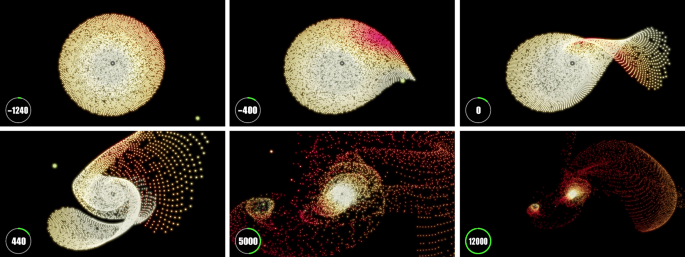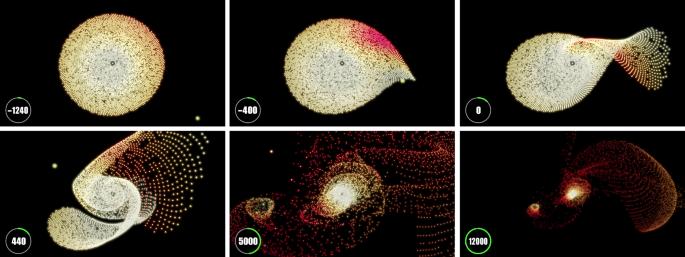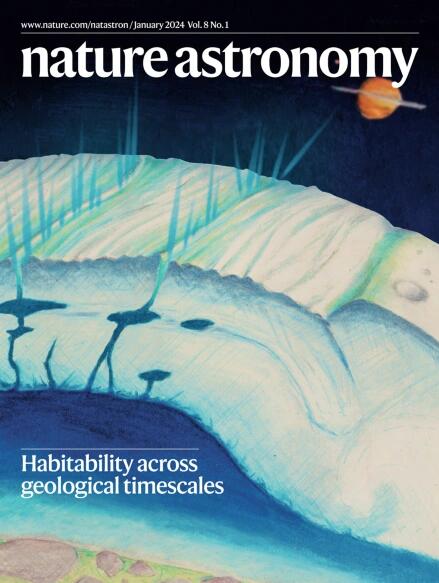塑造外太阳系的恒星飞越轨迹
IF 12.9
1区 物理与天体物理
Q1 ASTRONOMY & ASTROPHYSICS
引用次数: 0
摘要
与太阳系行星不同,海王星以外的数千个较小天体以偏心(e > 0.1 和 i >3°)轨道绕太阳运行。虽然在太阳系演化的早期阶段,巨行星的迁移可能会引起大量的跨海王星天体(TNOs)的散落,但这一过程无法解释行星覆盖范围之外的少量遥远的 TNOs(rp > 60 au)。另一种情况是近距离飞越另一颗恒星,这种情况可以同时产生所有这些 TNO 特征,但是这种相遇的可能参数空间非常大。在这里,我们将观测到的 TNO 特性与数千次飞越模拟进行了比较,以确定能够再现所有不同动态 TNO 群体、它们的位置和相对丰度的飞越的具体特性,并发现一颗 \(0.{8}_{-0.1}^{+0.1}\,{M}_{\odot }\) 恒星在 rp = 110 ± 10 au 的距离上通过,倾斜度为 i = 70°\({\,}_{-10}^{+5}\),给出了一个近乎完美的匹配。这次飞越也复制了逆行的 TNO 星群,事实证明这很难解释。这种飞掠相当频繁;银河系中至少有 1.4 亿颗太阳型恒星可能经历过类似的飞掠。鉴于这些结果,我们预测即将到来的维拉-鲁宾望远镜将揭示遥远的逆行 TNOs 是相对常见的。本文章由计算机程序翻译,如有差异,请以英文原文为准。


Trajectory of the stellar flyby that shaped the outer Solar System
Unlike the Solar System planets, thousands of smaller bodies beyond Neptune orbit the Sun on eccentric (e > 0.1 and i > 3°) orbits. While migration of the giant planets during the early stages of Solar System evolution could have induced substantial scattering of trans-Neptunian objects (TNOs), this process cannot account for the small number of distant TNOs (rp > 60 au) outside the planets’ reach. The alternative scenario of the close flyby of another star can instead produce all these TNO features simultaneously, but the possible parameter space for such an encounter is vast. Here we compare observed TNO properties with thousands of flyby simulations to determine the specific properties of a flyby that reproduces all the different dynamical TNO populations, their locations and their relative abundances, and find that a $$0.{8}_{-0.1}^{+0.1}\,{M}_{\odot }$$ star passing at a distance of rp = 110 ± 10 au, inclined by i = 70° $${\,}_{-10}^{+5}$$ , gives a near-perfect match. This flyby also replicates the retrograde TNO population, which has proved difficult to explain. Such a flyby is reasonably frequent; at least 140 million solar-type stars in the Milky Way are likely to have experienced a similar one. In light of these results, we predict that the upcoming Vera Rubin telescope will reveal that distant and retrograde TNOs are relatively common. The rocky disk surrounding the young Sun may have experienced a close flyby of another star. Simulations show that a highly inclined flyby of a star slightly smaller than the Sun at 100 au almost perfectly reproduces the orbits of the numerous small objects beyond Neptune.
求助全文
通过发布文献求助,成功后即可免费获取论文全文。
去求助
来源期刊

Nature Astronomy
Physics and Astronomy-Astronomy and Astrophysics
CiteScore
19.50
自引率
2.80%
发文量
252
期刊介绍:
Nature Astronomy, the oldest science, has played a significant role in the history of Nature. Throughout the years, pioneering discoveries such as the first quasar, exoplanet, and understanding of spiral nebulae have been reported in the journal. With the introduction of Nature Astronomy, the field now receives expanded coverage, welcoming research in astronomy, astrophysics, and planetary science. The primary objective is to encourage closer collaboration among researchers in these related areas.
Similar to other journals under the Nature brand, Nature Astronomy boasts a devoted team of professional editors, ensuring fairness and rigorous peer-review processes. The journal maintains high standards in copy-editing and production, ensuring timely publication and editorial independence.
In addition to original research, Nature Astronomy publishes a wide range of content, including Comments, Reviews, News and Views, Features, and Correspondence. This diverse collection covers various disciplines within astronomy and includes contributions from a diverse range of voices.
 求助内容:
求助内容: 应助结果提醒方式:
应助结果提醒方式:


